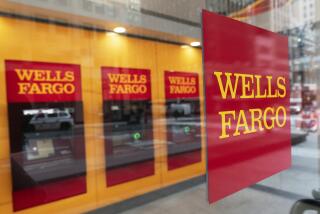Column: The Wells Fargo board is still getting a pass for failure
- Share via
On the surface, the Federal Reserve seemed really to lay the hammer on Wells Fargo & Co. for its accounts scandal and serial wrongdoing. In a sentence handed down Feb. 2, the Fed placed a cap on the bank’s future asset growth; the bank announced the departure of four unidentified directors, presumably at the regulator’s urging.
Investors certainly thought the punishment was harsh. Wells Fargo stock was battered to a 9.2% loss in Monday’s trading on the New York Stock Exchange. As my colleagues Jim Puzzanghera and James Rufus Koren reported, that was twice the loss suffered by the broad market on a bad day. Wells Fargo was down an additional 3.5% as of midday Tuesday, while the broad market was eking out a gain.
Yet former Treasury Secretary Lawrence Summers is correct to assert that the board members are “getting off too easy,” as the headline on his Washington Post op-ed had it on Tuesday. Summers noted that the four directors being ushered off the board have not yet been identified. They may not be named until the bank issues the proxy statement for its 2018 annual meeting, probably in mid-March.
Why aren’t the directors who are leaving being named and asked to resign effective immediately with an element of humiliation?
— Former Treasury Secretary Lawrence Summers
The bank calls this process “refreshment” of the board, which may be the least refreshing use of the term “refreshment” in business history.
“My question,” Summers wrote: “Why aren’t the directors who are leaving being named and asked to resign effective immediately with an element of humiliation?”
That’s a good question, but it doesn’t go far enough. We’d ask why only four directors are being dropped? And why is CEO Timothy Sloan, whose tenure with Wells Fargo goes back 30 years and included management responsibilities during the scandal, keeping his job? A new broom can sweep clean only if it’s genuinely new, but the board and top management at Wells Fargo will keep some very old bristles around.
Let’s quickly recap this bank’s history of scandal. In a practice first reported by the Los Angeles Times in 2013, bank employees opened bogus accounts for customers for years, evidently to meet brutal productivity goals imposed from above. In September 2016, the bank agreed to pay $185 million to regulators for that offense. Since then, the bank has acknowledged a host of other wrongs, including charging auto-loan customers for car insurance they did not need and charging improper fees to some mortgage borrowers.
Fed officials understood, in principle, where the blame rested. As part of the punishment, Michael Gibson, the Fed’s director of supervision and regulation, issued letters of chastisement to former Chairman and Chief Executive John Stumpf, former director and interim Chairman Stephen Sanger and the board as a whole.
Gibson told Stumpf that he provided “ineffective oversight” of practices he knew had “motivated compliance violations and improper practices.” Sanger was flayed for the “many pervasive and serious compliance and conduct failures ongoing during your tenure as lead independent director.” The board was told that its dereliction “contributed in material ways to the substantial harm suffered by WFC’s customers.”
These are strong rebukes. Yet the bank still seems reluctant to undertake a full scale housecleaning. Five directors, including Sanger, retired in 2017, and six new independent directors have been elected.
Yet there are seven holdovers from Wells Fargo’s wretched past; it’s unclear whether the four who will be leaving this year are members of this cadre because Wells is keeping their names to itself. Three will be leaving before the bank’s annual meeting in April, and the fourth by the end of the year.
The directors’ culpability for Wells Fargo’s misdeeds has never been in question. Sen. Elizabeth Warren (D-Mass.) last June called on then-Fed Chair Janet Yellen to remove all 12 who had been in place between May 2011 and July 2015, the period in which the fake accounts scandal was occurring. Of that dozen, nine are still on the board, including some with more than 10 years of inattentive service.
For handy reference, they are: business executive Enrique Hernandez Jr. (service since 2003); Dignity Health CEO Lloyd H. Dean (2005); BlackBerry CEO John Chen (2006); Florida businessman John D. Baker II (2009); former Vulcan CEO Donald M. James (2009); former Energy and Transportation Secretary Federico Peña (2011); former Deloitte CEO James Quigley (2013); former Fed Governor Elizabeth Duke (2015); and businesswoman Suzanne Vautrinot (2015). The bank plainly thinks highly of the last two — it has named Duke its new chairman and boasts of having placed Vautrinot on the board’s all-important risk committee.
Summers observes that Wells Fargo’s kid-gloves treatment of its departing directors, whoever they are, is utterly inconsistent with acknowledging their failure in their duties. “A trader or credit officer as extravagantly malfeasant would not be granted a dignified exit,” he wrote. “I find it hard to understand why regulators are so reluctant to foist public accountability on the individuals in responsible leadership positions when companies do the wrong thing.”
He’s right. In a world where the people truly in charge were subjected to punishment consistent with that meted out to the drones on the firing line who typically take the blame and pay the consequences, the bank and the Federal Reserve would make examples of all these people. Instead, they’ve been allowed to keep their prestigious posts, lauded for their experience and perspicacity, and paid lavishly — the nine collected an average of more than $372,000 for their board service in 2016, the latest year disclosed.
Given the depth of their failure, they should have been forced out long ago. Since that didn’t happen — and won’t happen even with the coming “refreshment” — the only conclusion to draw is that, for all the apparent severity of its punishment, Wells Fargo still hasn’t come to grips with its scandal.
Keep up to date with Michael Hiltzik. Follow @hiltzikm on Twitter, see his Facebook page, or email [email protected].
Return to Michael Hiltzik’s blog.
More to Read
Inside the business of entertainment
The Wide Shot brings you news, analysis and insights on everything from streaming wars to production — and what it all means for the future.
You may occasionally receive promotional content from the Los Angeles Times.











